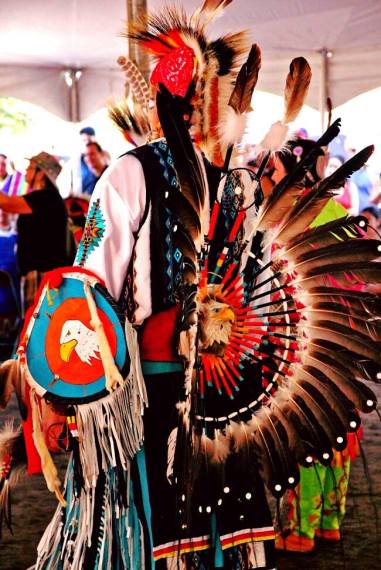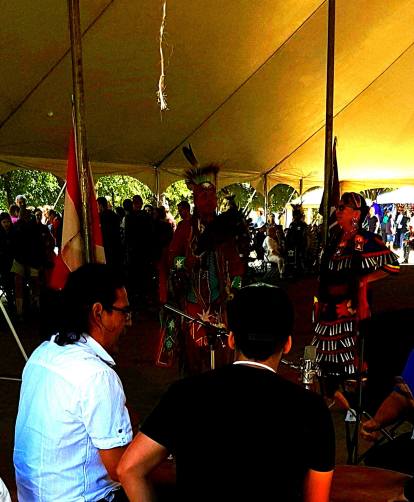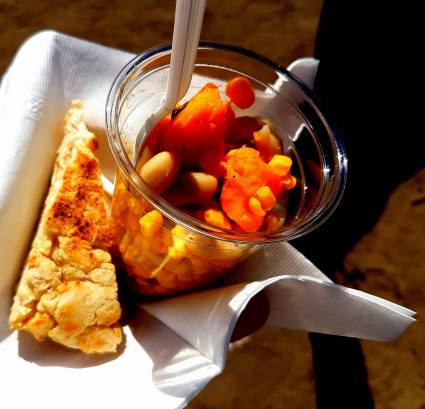

| Online: | |
| Visits: | |
| Stories: |
Drum, Dance, Craft and Community: Celebrating Indigenous Heritage at the McGill Annual Pow-Wow
By Adam J. Pearson
As I entered the Pow-Wow, I was struck by a rich tapestry of sounds: the thundering booms of steady drums, the wailing chants of singers, the shuffling of communities converging. I proceeded to the main tent and stood behind the drum circle. As the drum reverberated in my chest, my heart seemed to beat with it in unison.
According to Aboriginal tradition, the drum carries the spirit of Mother Earth; as my heart synchronized with the beat of the drum, it was as if it joined her in the song. The drummers sat in a circle, evoking the balance and harmony of the Medicine Wheel. Each musician held a single stick. They struck the drum in perfect unison, beating it simultaneously as one. Their music echoed the Indigenous theme of oneness in multiplicity; many sticks, one beat; many singers, one song; many lives, one Mother Earth.
Several traditional dances followed. Men’s traditional dances featured face-painted men adorned in ornate costumes accented with eagle-feathered head dresses and bright colours. Women’s traditional dances highlighted the skills of female dancers in radiant dresses. Some dances highlighted particular tribes, such as the Mohawk, on whose land we were all meeting as one. Other inter-tribal dances invited people of all tribes and nations to join in the dance, each person dancing in his or her own way, but all dancing together in a collective celebration united by booming drums and soaring voices. I felt honoured to be there, celebrating the beautiful culture of Canada’s First Nations peoples, who had determinedly preserved their traditions from the adversity of colonialism, assimilation, imperialism, and residential schools.
“Sharing my traditions and culture with all of you and with my children is for me… a form of healing,” said an Inuit singer between songs. “I was taken away from my parents as a child. To participate in these traditions is medicine for me.” Inuit throat singing amazed me with its relentless, rhythmic tones, dynamic vocalizations, and melodic complexity. Two female singers stood very close, facing one another. The syncopated rhythms of their voices offset each other melodically with a movingly hypnotic effect. The Inuit singers sang songs that echoed the landscapes and tools of the Arctic. “The River” captured the fluid movements of water coursing over smooth stones. “The Saw” mimicked the sound of a saw felling a tree. “The Love Song” represented a woman’s passionate attempt to win the love of a man who married her out of convenience. “Poor Little Puppy” vocalized the whining of a dog stuck in the porch area of an igloo.
The singers told us that Inuit women traditionally competed through these songs by seeing who could sing the longest without laughing. They sometimes even made bets with one another about who would win for sealskin boots, earrings, or even the heart of a capable hunter! After performing for us, the singers divided the spectators into two and taught us some basic throat singing techniques. I discovered that the trick was to make the song-sound (e.g. huh-muh) on the exhalation and inhale immediately after before rhythmically repeating the pattern. When I finished singing, I felt light-headed form the hyperventilation; it was easy to see how this music could produce an entrancing effect in the dimly fire-lit space of an Arctic igloo.
Afterwards, I walked around the booths with some friends and spoke with the craftspeople. Elegant bags, fine jewelry, and painted pipes were on offer, fine crafts embedded in thousands of years of cultural tradition. I spoke with people from the Indigenous Student Alliance, First Peoples’ House, Aboriginal Women’s Shelter, and the Montreal Network for solutions to problems in Indigenous communities. It was wonderful to hear about the inspiring work they were doing in the social work field. I ended my time at the Pow Wow by tasting some traditional Indigenous delicacies: bannock bread and corn, bean, and squash salad. All in all, my time at the Pow-Wow was a beautiful experience, a precious opportunity to learn about Aboriginal culture from Canada’s First Peoples and celebrate as one on the back of Turtle Island.
Read More from Adam Pearson at http://philosophadam.wordpress.com/
Source: https://philosophadam.wordpress.com/2016/09/16/drums-dance-crafts-and-community-celebrating-indigenous-heritage-at-the-mcgill-annual-pow-wow/






